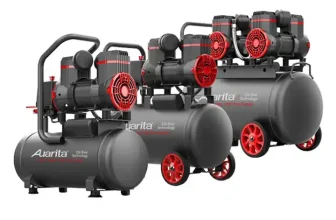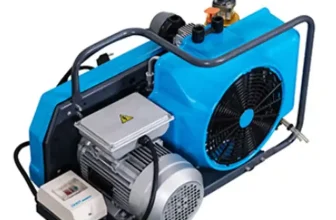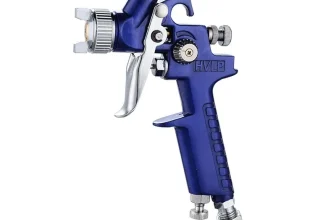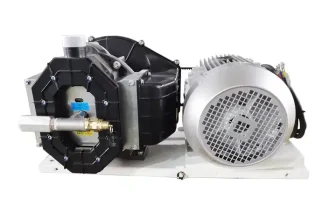Pancake air compressors are very handy and popular.
Most people store their pancake air compressor most of the time and use it only occasionally when needed.
This makes it even more important to pick the best pancake air compressor.
See our top Picks for the Best Pancake Air Compressors
Pancake?
Seems like a strange name for a shop tool doesn’t it?
Pancake air compressors get their name from the shape of their air storage tank.
The tank on these types of air compressors is wide and short, and they very much look like a pancake.
Main Advantages
There are several advantages of pancake air compressors over other larger compressors that you will find in shops and home garages.
If you can use these advantages then a pancake air compressor may be a good fit for your situation.
We will take a look at these main advantages.
Knowing these will help make sure you are able to pick the best pancake air compressor for you that will serve you well for years to come.
See our top Picks for the Best Pancake Air Compressors
Small Size
The first advantage of pancake air compressors in their small size.
Most compressors of this type have a tank size of around 6 gallons.
The size of these compressors is roughly the same size as a standard five gallon bucket.
Most common pancake air compressors weigh in around 30 pounds, so they are pretty lightweight for an air compressor.
Easy Storage
Pancake air compressors are very easy to store since they do not take up very much space at all.
As we mentioned in the last section, a pancake air compressor is only a little larger than a standard five gallon bucket.
This makes them very easy and convenient to store in just about an space, like a small closet or in the corner of your garage.
Because they are so easy to store, pretty much anyone will be able to take advantage of owning a pancake air compressor.
Low Maintenance
Pancake air compressors do not require very much in the way of maintenance.
This is in contrast to most types of larger air compressors.
Most larger air compressors have oil filled compressors which require oil much like a gasoline car engine.
This oil needs to be checked and changed on an interval specified by the air compressor manufacturer.
Most of the best pancake air compressors are of the oil free type.
Oil free compressors do not, as the name implies, require any oil to operate.
This makes them very easy to take care of and maintain, which is always an advantage with any kind of tool.
About the only thing you will need to do as far as maintenance goes with a pancake air compressor is clean or replace any air filter and maybe drain water from the tank if you live in an area with higher humidity.
We definitely think this qualifies the best pancake air compressor as low maintenance.
See our top Picks for the Best Pancake Air Compressors
Main Disadvantages
No tool is perfect, so there are some disadvantages to even the best pancake air compressors you will find.
For most light use these are minor disadvantages, and the advantages to a pancake air compressor will far outweigh the disadvantages for the vast majority of people.
But it is important to be aware of these disadvantages in case they are a deal breaker for your particular situation.
If one of these disadvantages is a deal breaker for you then even the best pancake air compressor will not be a good fit for you.
Noise Level
Even the best pancake air compressors can be on the noisy side compared to some other larger compressors for home and small shop use.
Generally an oil free compressor will be louder than one that requires oil, but there are some newer oil free designs that are quieter than previous ones.
It is best to check the specifications on the air compressors you are looking at to check their noise level if that is a concern for you.
Noise levels are measured in decibels, and hearing protection is recommended for anything louder than 85 decibels.
Also, keep in mind that the decibel scale is not linear, which means it does not increase at a constant rate as the number of decibels increases.
For each 10 decibel increase the sound level actually doubles.
So while it may seem that the difference between something like 55 decibels and 65 decibels is not that great it is actually the difference between normal conversation and the noise generated by an average vacuum cleaner.
As you know, a vacuum cleaner is much louder than the level of a normal conversation.
Capacity
The next disadvantage to keep in mind is that even the best pancake air compressor does not have a lot of capacity.
This is true for the air compressor’s reserve tank, where the air is stored before it is used as well as the air compressor’s actual compressor that fills the reserve take by compressing air.
These capacity limitations will affect what can be done with a pancake air compressor because some tools will require more capacity than even the best pancake air compressor can provide.
We will take a look at the primary things related to air compressor capacity you should be concerned with.
Pumping Capacity
The compressor’s pumping capacity which is normally specified in cubic feet per minute, CFM abbreviated.
This CFM rating is the amount of air the compressor can supply.
Most of the best pancake air compressors will have a CFM rating from 2 to 4 CFM.
You may also see air compressor pumping capacity listed in standard cubic feet per minute, abbreviated SCFM.
Standard cubic feet per minute rating will be different than just plain cubic feet per minute because it is measured at a standard temperature, humidity, and atmospheric pressure level.
SCFM was created to better compare different air compressors in a more standard way than the normal CFM manufacturer ratings since SCFM is specified under a stable set of conditions.
It is actually a little more complicated than that, but if you are just looking for the best pancake air compressor for your needs then you will only need to know that basics of this measurement.
See our top Picks for the Best Pancake Air Compressors
Reserve Tank Capacity
An air compressor’s reserve take is a tank where the compressed air is stored while it is waiting to be used.
The air compressor’s compressor will pull in air, compress it, and then store it in the reserve tank.
The reserve tank is a very important part of the air compressor because in most cases, especially with a smaller air compressors, the compressor itself cannot supply enough air at the needed pressure to power most air tools.
More on the Reserve Tank
Since the reserve tank stores air that air can be used to power a tool that need more air capacity than the compressor can provide.
This is especially important for a small compressor such as a pancake air compressor.
Generally the compressor will fill the tank until a certain pressure is achieved, then it will turn off until the reserve tank pressure drops below a preset level.
Once the reserve tank pressure falls below that level the compressor will start and try to refill the reserve air tank.
CFM and Tools
Just like CFM is a measure of pancake air compressor capacity it is also a measure of the amount of air a tool attached to an air compressor requires to operate properly.
All air tools should specify the amount of air they need in CFM, so you will be able to get an idea of how well your pancake air compressor will support that particular tool.
For example, if your pancake air compressor can supply 3 CFM of air, but your tool requires 2 then that tool should work fine with your air compressor.
One the other hand, if you have a tool that needs 4 CFM of air that tool would not work well with your pancake air compressor.
You do want to have a margin of extra capacity, usually 20 – 25%, of air compressor capacity in addition to the total CFM of all the tools you want to use at the same time.
The reserve air tank does allow you to use a tool with a higher CFM requirement than your compressor for a limited amount of time.
When using a tool with a higher CFM than the compressor can support the reserve air tank will be emptied faster than the compressor can fill it.
Once the tank pressure drop below the level needed for the tool, then you will have to stop using the tool and let the compressor refill the tank.
See our top Picks for the Best Pancake Air Compressors
PSI
The PSI rating of an air compressor specifies that maximum amount of air pressure it can supply.
You should make sure that the PSI of the pancake air compressor you buy is adequate for the tools you plan to use with it.
Most tools will specify the air pressure (PSI) they require to function properly.
One other thing to keep in mind is that a pancake air compressor can supply a little more CFM at a lower PSI than a higher PSI.
Tools will normally list their required CFM at a certain PSI.
Duty Cycle
Some pancake air compressors may list what is called a duty cycle.
A duty cycle is a common term with some tools, and it specifies how long the tool can operate continuously before needing to stop.
For example, it is very common for welders to list a duty cycle.
If a welder or other tool lists a duty cycle of say 20% that means that for a given amount of time the tool is only designed to operate 20% of that time.
Here’s an example of 20% duty cycle:
Over the course of 10 minutes a tool with a duty cycle of 20% is only designed to operate for 20% of that time, or 2 minutes out of the total 10 minutes in this case.
Common Features
Most pancake air compressors will have everything included that you will need to start using your new compressor.
You will just have to plug it in, connect your tools, and then you will be ready to go.
Be sure to read all of the instructions that come with your new compressor to make sure there is nothing else you need to do before you start using your new pancake air compressor.
You will usually find a pressure regulator included that will allow you to adjust the output pressure of your pancake air compressor.
Most pancake air compressors will have two pressure gauges, one for showing how much pressure (PSI) is in the tank, and then the other will show the output pressure the connected tools will receive.
The last common feature we will mention you will find on most pancake air compressors is two connectors to connect air tools.
Just keep in mind the combined CFM of all connected tools that will be used at the same time when determining if your air compressor will work for your intended use.
See our top Picks for the Best Pancake Air Compressors
Common Usages
Their small size, low maintenance, easy storage make pancake air compressors a popular choice for many applications from inflating tires and sports equipment to powering air tools like nail guns.
They are best suited for air tools that need either bursts of air, like a nail gun that we just mentioned or some other tool that does not require a large amount of CFM to operate.
Something like an air grinder that needs a continuous supply of air at a higher CFM that even the best pancake air compressors can provide would not be a good fit.
Although you could technically use an air grinder with a pancake air compressor it would drain the reserve tank pretty quickly, and you would spend a lot of time waiting for the pancake air compressor to refill the reserve tank.
Our Picks
We have done quite a bit of research on the best pancake air compressors and have compiled a list of our top picks.
Click the button below to see our picks!
See our top Picks for the Best Pancake Air Compressors







